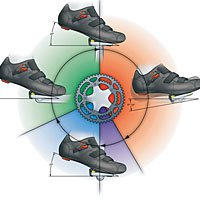The Perfect Pedal Stroke
Pedaling in a simple circle is a complex thing, but mastering it can save energy.
Pedaling in a simple circle is a complex thing, but mastering it can save energy. By Loren Mooney
Todd Carver, biomechanist at Colorado’s Boulder Center for Sports Medicine, says that with proper ankling (shown above), riders can churn out the same amount of power at a heart rate as many as five beats per minute lower. This stroke is for flat terrain at threshold, or time trial, intensity.
Hip-Knee-Ankle Alignment: Viewed from the front, your hip, knee and ankle should line up throughout the pedal stroke. “You don’t want knee wobble,” says Carver. “Just think pistons, straight up and down.” If you can’t correct this, or if you experience knee pain when you try to restrict lateral movement, you may need orthotics or another type of biomechanical adjustment.
Zone 1: Known as the power phase, the portion of the pedal stroke from 12 o’clock to about 5 o’clock is the period of greatest muscle activity. “A lot of people think hamstrings are used only on the upstroke,” says Carver, “but a good cyclist uses a lot of hamstring in the downstroke, because it extends the hip.” The key to accessing the large muscles in the back of your leg is dropping your heel as you come over the top of the stroke, says Carver. “At 12 o’clock, your toes should be pointed down about 20 degrees, but as you come over the top, start dropping that heel so that it’s parallel to the ground or even 10 degrees past parallel by the time you get to 3 o’clock.” The biggest mistake Carver sees in novice riders: not dropping the heel enough in Zone 1.
Zone 2: Using the same muscles as in the power phase, but to a lesser degree, this phase acts as a transition to the backstroke. “As you enter Zone 2, think about firing the calf muscles to point your toe,” Carver says. As you come through the bottom of the stroke, the toe should be pointed down 20 degrees. “This ankling technique transfers some of the energy developed in Zone 1 by the bigger muscles to the crank,” Carver says. He uses the advice popularised by Greg LeMond: “Act like you’re scraping mud off the bottom of your shoe.”
Zone 3: Even though you feel like you’re pulling your foot through the back of the stroke, you’re not. “When you look at even the best cyclists, they’re losing power on the upstroke,” says Carver. “The pedal is actually pushing your leg up, so the goal is to lose as little power as possible and get that foot out of the way.” One fun way to improve the efficiency of your upstroke: mountain biking. “The terrain keeps you honest,” Carver says. “If you’re focusing only on the downstroke, you’ll lose traction and fall off your bike in steep sections.” As for other exercises, Carver advises against single-leg pedal drills–“for recreation-level riders, they injure more people than they help”–but recommends hamstring and glute-strengthening lifts, as well as squats, “done correctly, in a squat rack with someone showing you how.”
Saddle Position: Proper bike fit, especially saddle height and fore-aft adjustment, is a prerequisite for a smooth pedal stroke. Without it, says Carver, you won’t be even remotely as efficient as you could be. “If your saddle is too high, you’re not going to be able to drive your heel effectively,” he says. “If it’s too low, you’ll have knee pain.” In the right position (knee over the ball of your foot with the pedal at 3 o’clock; knee slightly bent with the pedal at 6 o’clock), you’ll maximise your energy output and also be able to adapt your ankling technique to different terrain, cadence and effort levels.
Zone 4: As you enter the second half of the upstroke phase, think about initiating your downstroke. “Many riders don’t initiate early enough,” says Carver, who often sees riders wait until 3 o’clock–but they should be starting before 12 o’clock. A tip: As you begin to come across the top of the stroke, think about pushing your knee forward, toward the bar. But only your knee, says Carver: “Your pelvis should remain a stable platform, not sinking down and not moving forward.”
READ MORE ON: Skills training programmes workouts


